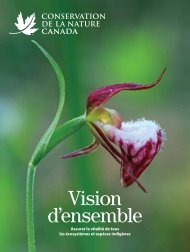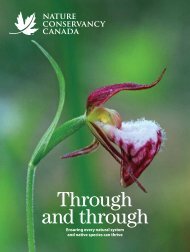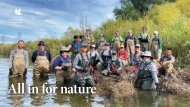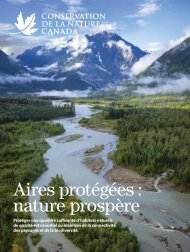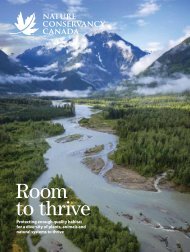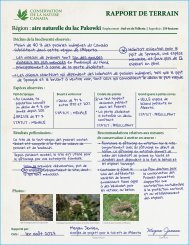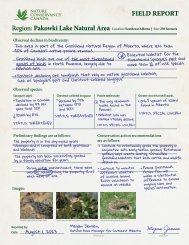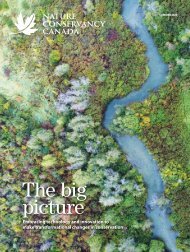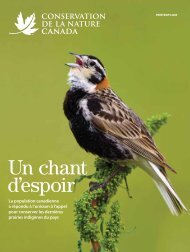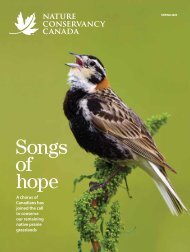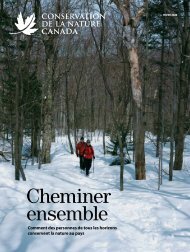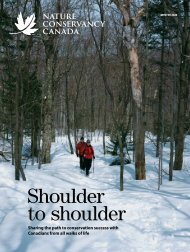Create successful ePaper yourself
Turn your PDF publications into a flip-book with our unique Google optimized e-Paper software.
Left: Volunteers work<br />
together to remove<br />
invasive species.<br />
Bottom: Purple martin<br />
nest boxes installed on<br />
new wetlands at Chase<br />
Woods Nature Reserve.<br />
Transforming ecosystems<br />
Lesley Marian Neilson, <strong>NCC</strong> communications<br />
manager for BC, says volunteer efforts are<br />
crucial in helping transform ecosystems heavily<br />
affected by development or agriculture.<br />
“Historically, these lands were tidally flooded<br />
wetlands,” she describes, noting that, in<br />
the past, wetlands have made up less than<br />
three per cent of the BC coast. “This area<br />
used to be directly connected to the estuary.<br />
It would have been used by juvenile salmon<br />
and other intertidal species. But that ended<br />
when the dikes were built and the wetlands<br />
were turned into hayfields. We have lost most<br />
of the wetlands on Vancouver Island over the<br />
past century. This has a serious impact on the<br />
birds, fish, amphibians and other wildlife that<br />
require wetlands to live. So restoring wetlands<br />
is a vital conservation action,” she adds,<br />
watching as violet-green tree swallows swoop<br />
low over the landscape, darting in and out of<br />
newly constructed nesting boxes.<br />
The initial work required heavy machinery<br />
to pull out the top layer of reed canarygrass<br />
and dig channels to reproduce the winding<br />
path of a creek that had been diverted into<br />
a deep ditch to drain the marshland.<br />
“Restoration projects can look very messy<br />
at first, as we remove what shouldn’t be here<br />
to recreate the environments required by<br />
wildlife. Here, we have introduced piles of<br />
logs and mounds of earth in and around the<br />
The loss of species and habitats is the result<br />
of death by a thousand cuts. It’s going to<br />
require thousands of restoration actions to<br />
bring some of that back.<br />
ponds to establish a natural wetland structure.<br />
These provide niche habitats for different species,”<br />
Neilson explains.<br />
“Nature is so resilient, and sometimes it<br />
just needs a helping hand to undo some of the<br />
damage and start coming back.”<br />
The invasive reed canarygrass is a beast to<br />
knock back since, if even a bit of root is left<br />
the plant will start growing again.<br />
“But, if we can reduce its abundance, the<br />
native plants will become more established,<br />
and the ecosystem will begin to shift to a natural<br />
marsh wetland. It’s not a one-time endeavour;<br />
it will take years of management and<br />
restoration,” says Neilson.<br />
Restoration ecology<br />
Dan Kraus, <strong>NCC</strong> senior conservation biologist,<br />
explains that the science of restoration<br />
ecology developed out of a growing need to<br />
bring back disappearing species and habitats,<br />
not only to conserve biological diversity, but<br />
also to benefit people.<br />
“The loss of species and habitats is the<br />
result of death by a thousand cuts. It’s going<br />
to require thousands of restoration actions<br />
to bring some of that back,” he says.<br />
Kraus emphasizes that acquiring and restoring<br />
one or two properties in an area can<br />
be seen as a drop in the bucket, but when<br />
cumulative restoration work continues for<br />
decades, it makes a real difference.<br />
<strong>NCC</strong>’s restoration projects include tree<br />
planting, management of invasive plants<br />
and reintroducing natural processes, such<br />
as bringing fire back to the landscape.<br />
“Traditionally, <strong>NCC</strong> has focused on habitat<br />
restoration, hoping that, if we restore it, they<br />
will come, but for some plants and animals, they<br />
simply cannot get there on their own,” he adds.<br />
“There is a growing need to reintroduce<br />
endangered animals on our properties. For<br />
example, we’re partnering with the Calgary<br />
Zoo to bring back the greater sage-grouse,<br />
a grassland bird that is endangered in both<br />
Canada and the U.S.”<br />
MELISSA RENWICK.<br />
10 SPRING <strong>2020</strong> natureconservancy.ca



